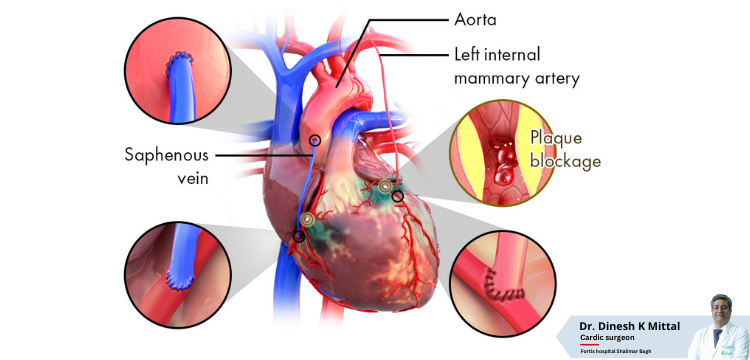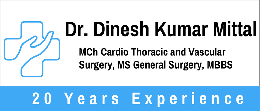Congenital Heart Procedures Cost in Delhi | Dr. Dinesh Kumar Mittal

What does “congenital” mean? It suggests having been alive since birth. Congenital heart disease refers to structural cardiac abnormalities that appear at birth. This happens when the heart does not develop properly during pregnancy. It alters the blood flow via the hub.
Typical problems encompass openings in the heart wall, improper blood flow through vessels, and faulty heart valves. With advancements in medical care, children born with this condition can lead lengthy and healthy lives. Let’s delve deeper into the origins and signs of this ailment and strategies for managing it effectively.
Congenital heart illness is the most frequent congenital impairment worldwide. Around 200,000 infants are projected to be born with this condition yearly. However, because of developments in diagnostic technology, healthcare practitioners may now discover most congenital defects before the child is born. Some genetic heart disease instances are found after the baby is born. Approximately 25% of congenital defects require surgery within the first year of a baby’s life.
Dr. Dinesh Kumar Mittal, a leading expert in the field of Congenital Cardiac Surgery, has made significant contributions to the care and treatment of children born with congenital heart defects. His dedication to advancing surgical techniques and improving patient outcomes has played a pivotal role in ensuring that infants with these conditions have access to the highest quality of care, ultimately enabling them to lead healthy and fulfilling lives.
What Causes Congenital Heart Diseases?
According to Dr. Dinesh Kumar Mittal, Congenital cardiac abnormalities can be caused by various factors. While establishing the particular cause in each case may be challenging, various possible factors contribute to the development of congenital heart diseases:
- Chromosomal Abnormalities: A child may inherit certain genetic factors that cause incorrect cardiac development.
- Environmental factor: Toxin exposure during pregnancy, such as toxins contained in cigarettes, recreational drugs, or alcohol, may raise the chance of congenital cardiac defects.
- Viral Infection: Infections acquired by the woman during pregnancy may harm the developing baby’s heart.
- Chronic Maternal Illness: Diabetes, phenylketonuria, and autoimmune illnesses in the mother can increase the newborn’s chance of congenital heart disease.
Dr. Mittal emphasizes the need to know these potential reasons to enhance congenital heart disease prevention and treatment efforts. Early identification and intervention’s importance in achieving the best results for afflicted persons cannot be overstated.
What are the Symptoms of Congenital Heart Disease?
Although this form of undiscovered cardiac illness is uncommon, there are occasions when the warning signs go ignored. Keep an eye out for the following congenital heart disease symptoms and signs:
- A fast heartbeat
- Blue-tinged skin, fingernails, or lips characterize Cyanosis.
- Breathing difficulty
- Unexplained exhaustion
- Swollen feet, ankles, eyes, and hands
- Murmurs in the heart
- Reduced pulse
- Inadequate blood circulation
- Chest ache
- Heart rhythm irregularities
- Infants’ poor feeding (tiredness when breastfeeding)
What are the Types of Congenital Heart Disease?
Medical specialists divide congenital heart abnormalities into cyanotic (low oxygen levels) and non-cyanotic (abnormal blood circulation). The following are the most prevalent kinds of congenital cardiac disease:
1) Heart Defects in Cyanotic Patients
These are issues that occur when the body obtains less oxygen than average. The skin turns blue in tone. Some examples of cyanotic heart defects are as follows:
- Left and right heart obstructive lesions (undeveloped structures and blockages in the heart)
- Mixing lesions (mixing of pulmonary and systemic blood flow)
- Truncus Arteriosus (just one blood artery exiting the heart instead of two)
- Artery transposition (the pulmonary artery and the aorta are switched)
2) Heart Defects Other Than Cyanotic
There is plenty of oxygen in this form. In contrast, blood circulation is abnormal. This defect disrupts regular blood flow. Non-cyanotic cardiac anomalies include:
- Aortic stenosis narrows the aortic valve
- An atrial septal defect is a heart chamber wall hole
- Unusual valve action
- The narrowing of the pulmonary valve is known as pulmonary stenosis.
Is there a Danger?
Dr. Dinesh Kumar Mittal, a congenital heart surgery expert, emphasizes that a number of crucial factors may enhance the risk of congenital heart disease in newborns. These factors include:
- Heart disease is hereditary
- Certain medications used during pregnancy
- Use of cigarettes or alcohol during pregnancy
- Rubella (the virus that causes measles) exposure during pregnancy
- Pregnant ladies who are obese
- Fetal or chromosomal abnormalities
Dr. Mittal’s understanding of these risk factors emphasizes the significance of early identification and proactive actions to reduce risks and provide the best treatment possible for children born with congenital cardiac problems.
How Are Congenital Heart Defects Diagnosed?
Dr. Mittal explains the diagnostic process for congenital heart defects. The diagnosis may be made via a prenatal risk assessment. Doctors may also perform it at the baby’s first physical exam after birth.
Some of the most common tests are:
- Fetal echocardiogram before birth to detect heart anomalies.
- Chest X-ray to identify anatomical abnormalities in the heart and lungs.
- ECG (Electrocardiogram) to pinpoint irregular heartbeats.
- Echocardiography to assess blood flow rate.
- Pulse oximetry to measure blood oxygen content.
- Stress tests to observe the heart’s response to physical exercise.
- MRI (magnetic resonance imaging) scan of the heart for a comprehensive evaluation.
Some patient testimonials reflect the patients’ and their family members’ feelings about Dr. Mittal. “When I initially discovered about my child’s congenital heart issue, I felt bewildered and afraid,” Amina says. However, Dr. Mittal and his colleagues gave us excellent medical treatment and a welcoming sense of home. Their knowledge and compassion cut across boundaries, and my child received the greatest treatment imaginable. Dr. Mittal’s passion for preserving small hearts has no boundaries, and my family and I will be eternally thankful.”
Ahmed, an African person, expresses his gratitude: “Travelling across continents for medical treatment can be overwhelming, but Dr. Mittal and his team made it a seamless journey for us. Their commitment to excellence in congenital heart surgery is remarkable. Dr. Mittal’s skills and his clinic’s warm, welcoming environment made our experience positive. Thanks to him, my child now has a chance at a healthier life, and we couldn’t be more thankful.”
How can Congenital Heart Disease be Prevented and Treated?
Some congenital heart diseases improve over time without treatment. Some newborns may need surgery soon after delivery. Cardiovascular surgeons and pediatric cardiologists carry out these procedures.
During therapy, the following methods could be used:
- Cardiac catheterization is an invasive treatment to improve blood flow or place plugs
- Treatment with oxygen
- Medications for high blood pressure and circulatory stimulants
- Heart surgery includes repairing heart defects, replacing heart valves, and conducting heart transplants
- Pacemakers and defibrillators are implanted cardiac devices
Reducing your risk factors is crucial to preventing congenital heart disease. Here are some options:
- Alcohol and smoking should be avoided.
- Do not use any unknown or unnecessary medications.
- When pregnant, maintain a healthy weight.
- Follow the prenatal screening guidelines to diagnose the illness (if it exists) as early as possible.
Living with Heart Congenital Defects
Individuals with congenital heart disease must get continuing medical care, maintain a healthy lifestyle, and undergo regular check-ups. Cardiac rehabilitation can help strengthen your heart while minimizing your risks and effects. Another effective strategy to cope with the sickness is joining a support group network.
What is the Cost of Congenital Heart Procedures in India?
Treatment expenses for congenital heart disease (CHD) in India for Indian patients range from Rs. 1,77,600 to Rs. 2,36,800, whereas international patients incur costs ranging between USD 3,600 to USD 4,400. However, these estimated costs might vary based on individual patient’s needs, the complexity of the procedure, hospital preferences, additional medical examinations, and the patient’s overall health condition.
Conclusion
Over 90% of infants born with congenital heart illness survive adulthood. It speaks a lot about the improved care and treatment alternatives for this condition that are now available. Depending on the severity of the issue, a child may need invasive or minimally invasive heart surgery to be corrected. Engaging in suitable medical treatment and adhering to scheduled check-ups with your healthcare provider enhance your prospects of managing this condition conservatively.
Frequently Asked Questions (FAQs)
1. What exactly are congenital cardiac defects?
Congenital heart defects are structural disorders in the heart that occur at birth. They can harm the heart’s chambers, valves, or blood arteries.
2. How can I understand if my child has a congenital heart defect?
Symptoms might vary, but frequent indicators include fast breathing, poor eating, and blue skin. A pediatrician can evaluate your child’s health.
3. Is congenital cardiac surgery safe for newborns and children?
Yes, advanced technology and expert surgeons have substantially increased safety. However, all procedures have risks that should be discussed with your medical team.
4. What is the recuperation process like for children who have heart surgery?
Recovery varies, but with careful monitoring, most children can return to normal activities within a few weeks to a few months.
5. Is it possible to diagnose congenital heart abnormalities during pregnancy?
Some are detectable during prenatal screening. For further information, speak with your OB-GYN.
